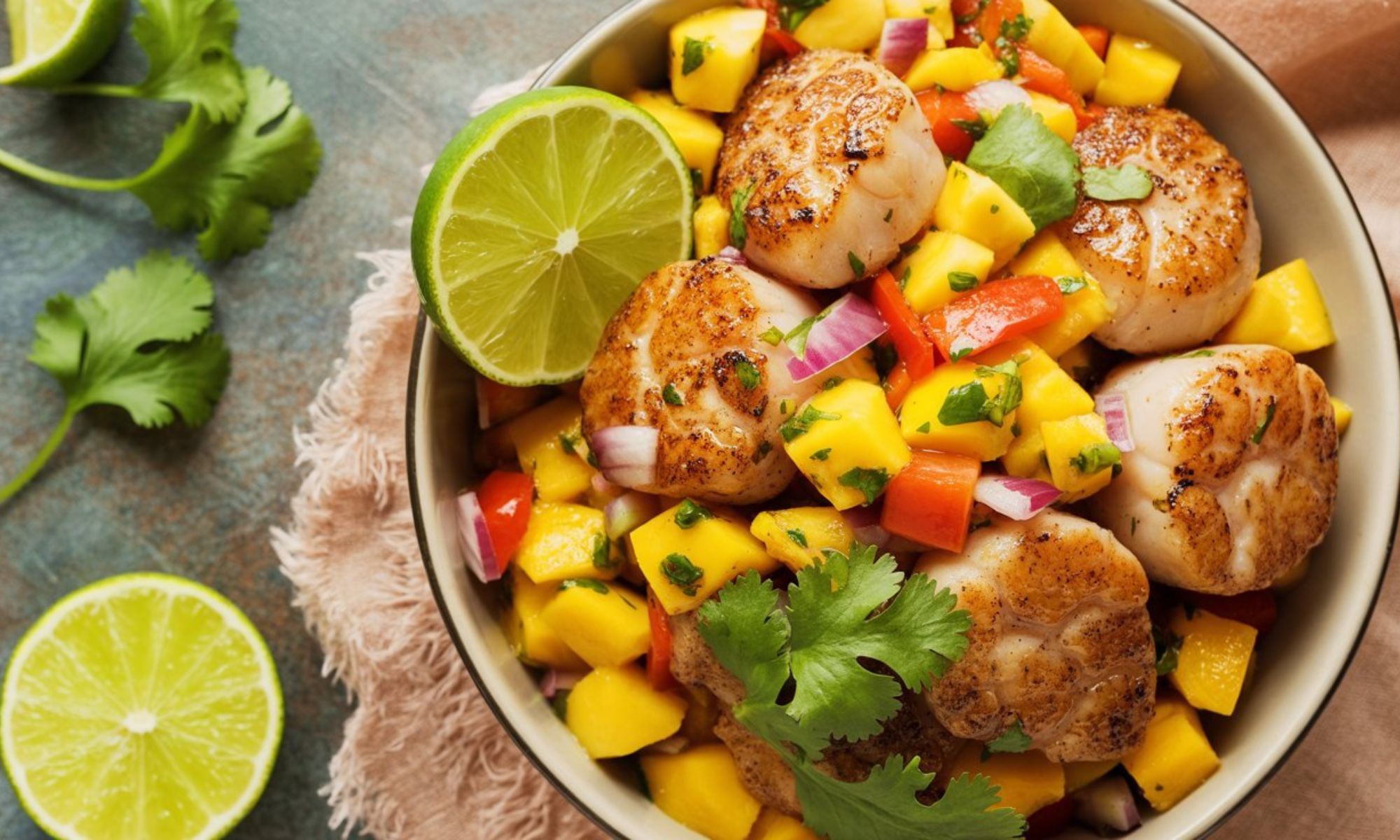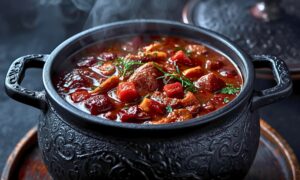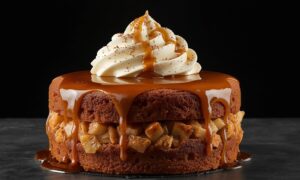Forget everything you think you know about “difficult” seafood dishes. That intimidation you feel when scallops show up on a menu? It’s about to disappear forever. Island Style Seared Scallops With Mango Salsa isn’t just another recipe – it’s your gateway to mastering restaurant-quality cooking at home with techniques so simple, you’ll wonder why you waited this long.
Here’s what changes everything: scallops cook faster than scrambled eggs and forgive mistakes better than chicken breast. When you pair them with a mango salsa that hits every flavor note imaginable, you’re creating something that’ll make your regular weeknight dinners feel embarrassingly basic. This Island Style Seared Scallops With Mango Salsa recipe transforms fifteen minutes and basic ingredients into a dish worthy of your fanciest dinner party.
The secret lies in understanding heat, timing, and trusting the process. No culinary school required.
Why Island Style Seared Scallops With Mango Salsa Deserves Your Attention
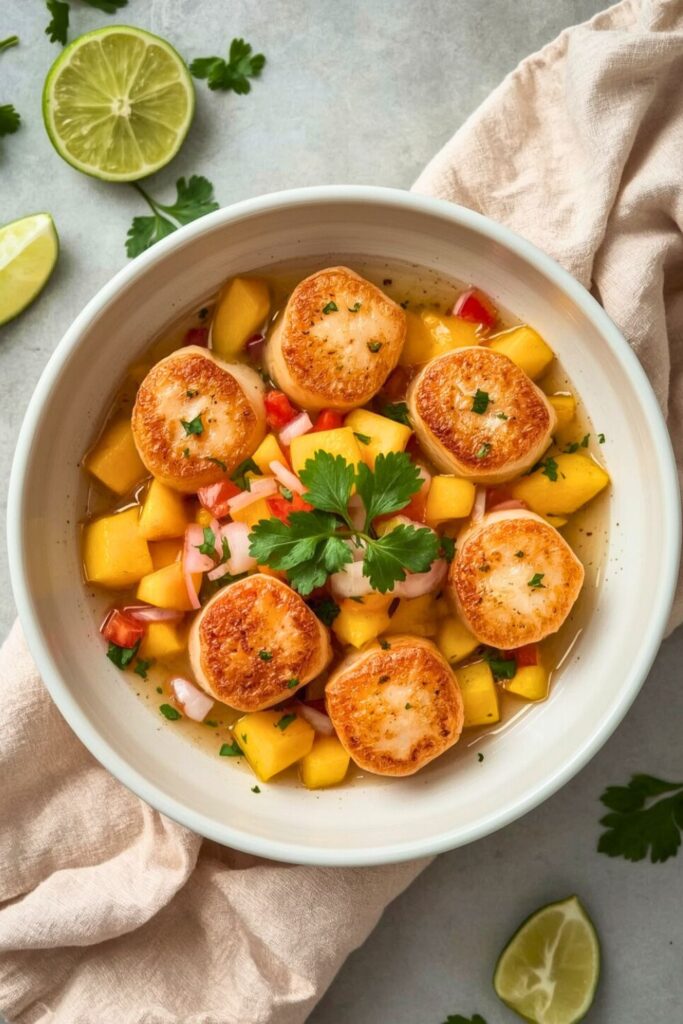
Most home cooks dodge scallops like they’re handling explosives. Reality check: they’re more forgiving than most proteins you already cook. The magic happens when you stop overthinking and start understanding what’s actually going on in that pan.
This dish brings together buttery, caramelized scallops with a salsa that’ll ruin you for store-bought versions forever. We’re talking sweet mango, fiery jalapeño, bright lime, and fresh herbs creating flavor combinations that coastal communities have refined over generations.
Here’s something fascinating about island cooking traditions – they’ve always understood balance intuitively. Sweet tropical fruits counter spicy peppers. Rich seafood gets brightened by citrus. These aren’t random pairings – they’re culinary wisdom passed down through generations of cooks who understood flavor harmony long before food science explained why it works.
The beauty of this particular recipe lies in its accessibility. You don’t need specialty equipment or hard-to-find ingredients. Everything comes together in your regular kitchen with techniques you can master in one attempt.
It’s comfort food disguised as fine dining. And it’s about to become your new signature dish.
Essential Ingredients for Perfect Island Style Seared Scallops With Mango Salsa
For the Scallops:
- 1½ pounds large sea scallops (12-16 pieces)
- 2 tablespoons high-heat oil (avocado or grapeseed)
- 2 tablespoons unsalted butter
- Sea salt and freshly cracked black pepper
- 1 lime, cut into wedges
For the Mango Salsa:
- 2 ripe mangoes, diced small (about 2 cups)
- 1 red bell pepper, finely chopped
- ½ small red onion, minced
- 1 jalapeño, seeded and minced
- ¼ cup fresh cilantro, chopped
- 2 tablespoons fresh lime juice
- 1 tablespoon honey or agave nectar
- ½ teaspoon kosher salt
- ¼ teaspoon ground cumin
Smart Swaps That Actually Work
Can’t find sea scallops? Bay scallops work with shorter cooking times. No fresh mango? Thawed frozen mangoes work brilliantly. Missing jalapeño? Red pepper flakes provide similar heat. Cilantro hater? Fresh mint creates different but delicious flavor.
Here’s your scallop-buying secret: they should smell like ocean breeze, not fish market. Good scallops feel firm and look slightly translucent. That milky liquid in the package? Not ideal. Those tough side muscles? Pull them off before cooking.
Shopping tip that’ll save you money: buy scallops the day you plan to cook them. They’re best within 24 hours of purchase. If you must store them, place them on ice in the coldest part of your refrigerator and use within two days maximum.
Look for “dry” scallops whenever possible. These haven’t been treated with phosphates, which means better flavor and superior searing. They cost slightly more but deliver significantly better results. “Wet” scallops release excess moisture during cooking, making that gorgeous golden crust nearly impossible to achieve.
Mastering the Island Style Seared Scallops With Mango Salsa Technique
Prep Your Mango Salsa First
Start with the salsa because it improves while waiting. Dice mangoes into ¼-inch pieces – small enough for easy eating, large enough for texture. Mix all salsa ingredients and let them mingle at room temperature.
The lime juice mellows the onion’s bite while honey harmonizes every flavor. This isn’t just mixing ingredients – it’s creating balance.
The Scallop Searing Science
Pat scallops bone dry with paper towels. Moisture steams instead of sears, robbing you of that gorgeous golden crust. Season generously just before cooking – salt draws out moisture if applied too early.
Heat your heaviest pan over medium-high heat. Cast iron excels here, but any heavy-bottomed pan works. You want water droplets to sizzle and vanish immediately.
Add oil and wait for that telltale shimmer. Place scallops with space between each one. Listen for that satisfying sizzle. Don’t move them. Don’t peek. Don’t even think about touching them for 2-3 minutes.
The Perfect Flip for Island Style Seared Scallops With Mango Salsa
Patience creates perfection here. That golden crust forms through the Maillard reaction – it needs time and steady heat. When you can slide a spatula underneath easily, they’re ready.
Flip gently and add butter to the pan. Watch it foam and turn nutty – that’s beurre noisette adding incredible depth. Baste scallops with this foamy butter using a spoon.
Another 1-2 minutes and you’re done. Scallops should remain slightly translucent in the center – think medium-rare for seafood.
The Science Behind Perfect Island Style Seared Scallops With Mango Salsa
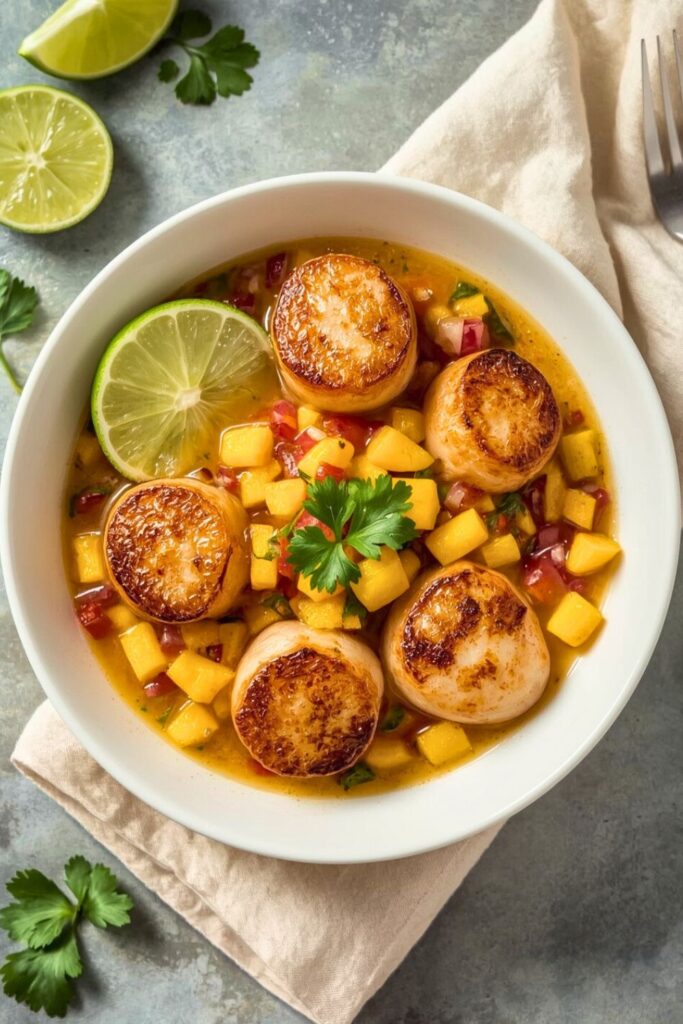
High heat breaks down proteins and creates new flavor compounds through caramelization. Surface moisture evaporates quickly, allowing exteriors to reach browning temperatures. Moving scallops too soon tightens delicate proteins, creating rubbery texture.
That finishing butter contains milk proteins that brown beautifully. The foaming indicates perfect temperature for enhancement, not overpowering. Mango salsa works on multiple levels – lime acidity brightens rich scallops while mango sweetness echoes their natural flavor.
Jalapeño heat creates contrast, and cilantro adds herbal notes tying everything to island traditions.
Plating Your Island Style Seared Scallops With Mango Salsa Like a Pro
Start with a generous spoonful of colorful mango salsa center-plate. Those golden mango pieces, red pepper bits, and green cilantro create Instagram-worthy visuals before anyone takes a bite.
Place seared scallops directly on or slightly overlapping the salsa. Golden-brown crust faces up, showcasing your searing skills. A lime wedge isn’t just decoration – it offers brightness control for individual preferences.
Wine Pairing Perfection
Crisp, light wines complement without competing. Sauvignon Blanc or Pinot Grigio acidity enhances mango salsa beautifully. Beer lovers should reach for wheat beers or light lagers.
Keep sides simple. Coconut rice, grilled asparagus, or lime-dressed mixed greens won’t overshadow these starring flavors.
Advanced Tips for Island Style Seared Scallops With Mango Salsa Success
Temperature control matters more than most realize. Medium-high heat maintains consistent searing without burning. Cast iron retains heat better than thin pans, creating more even crusts.
The salsa benefits from 30-minute resting time. Flavors meld and intensify while acidity mellows harsh onion notes. Make it ahead for better results.
Quality ingredients make noticeable differences. Fresh lime juice outperforms bottled versions significantly. Ripe mangoes provide natural sweetness that balances jalapeño heat brilliantly.
Here’s a pro secret about scallop storage: if you’re not cooking them immediately, arrange them on a plate lined with paper towels, cover loosely with plastic wrap, and refrigerate. Change the paper towels if they become damp. This keeps them at optimal moisture levels for searing.
For the ultimate island experience, try grilling your scallops instead of pan-searing. Use a grill basket or thread them onto skewers. The smoky char adds another dimension to the Island Style Seared Scallops With Mango Salsa flavor profile.
Consider making extra mango salsa – it transforms grilled chicken, fish tacos, or even scrambled eggs into something special. It keeps well in the refrigerator for up to three days and actually improves as the flavors develop.
Troubleshooting Your Island Style Seared Scallops With Mango Salsa
Scallops sticking usually means insufficient heat, excess moisture, or premature movement. Let them cook longer – they’ll release when crusts form properly. Next time, ensure proper preheating and complete drying.
Rubbery texture indicates overcooking. Scallops cook quickly – 2-3 minutes per side maximum. They should feel firm but yielding, like pressing flesh between thumb and forefinger.
Bland salsa needs more acid or salt. Taste and adjust lime juice first, then salt. Mangoes vary in sweetness – balance accordingly.
Making Island Style Seared Scallops With Mango Salsa Your Signature Dish
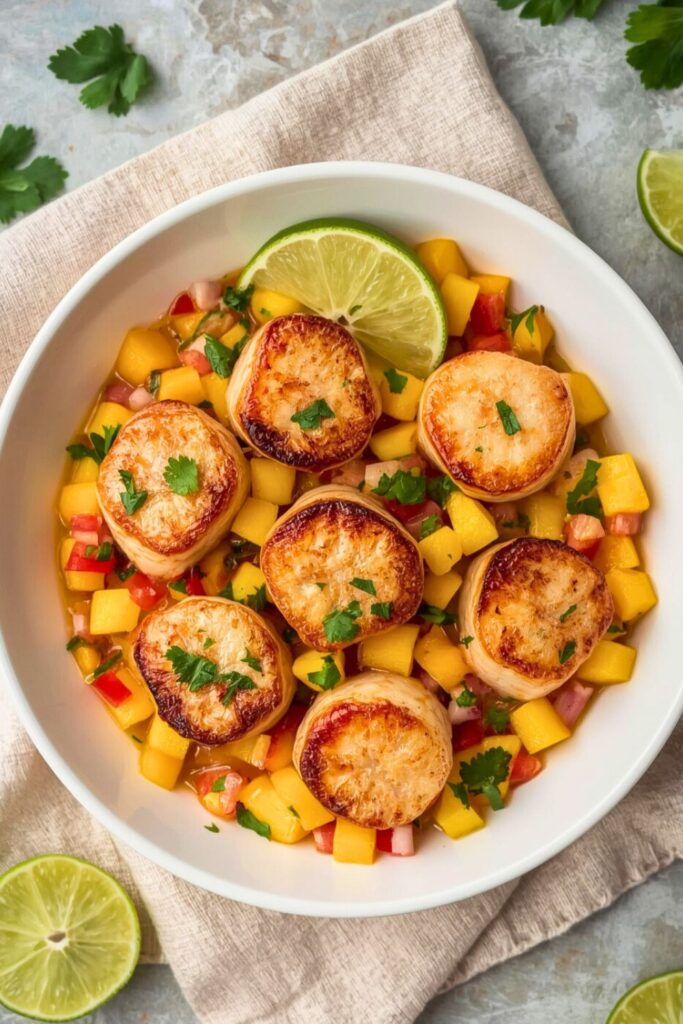
This recipe works for date nights, family dinners, or impressive entertaining. Prep happens ahead, cooking takes minutes, results look professionally crafted. The combination of technique and fresh flavors creates memorable dining experiences.
Confidence comes from understanding ingredients and trusting the process. Scallops seem intimidating but forgive mistakes better than most proteins. Master this technique, and seafood cooking becomes approachable.
The versatility of this dish surprises most people. Serve it as an elegant appetizer for dinner parties, or double the portions for a stunning main course. The mango salsa works beautifully with other proteins too – try it with grilled shrimp, seared tuna, or even roasted pork tenderloin.
Want to make it even more special? Add a drizzle of coconut cream or a sprinkle of toasted coconut flakes for extra tropical flair. A few microgreens or edible flowers turn this into restaurant-presentation territory.
The timing works beautifully for entertaining. Make the salsa hours ahead, prep your scallops, then execute the final searing while guests mingle. The cooking happens so quickly, you’ll barely miss any conversation.
Start with quality ingredients, don’t overthink the process, let island flavors transport you somewhere warm and tropical, regardless of season.
Frequently Asked Questions
How do I know when my Island Style Seared Scallops With Mango Salsa scallops are perfectly cooked?
Perfect scallops show golden-brown seared sides and slight center translucency. They feel firm but yielding when gently pressed – similar to the flesh between thumb and forefinger in an “OK” sign. Overcooked scallops become rubbery and opaque throughout.
Can I prepare the mango salsa component ahead of time?
Absolutely – it actually improves with time. Make salsa up to 4 hours ahead at room temperature or 24 hours refrigerated. Return to room temperature before serving and stir to redistribute juices.
What causes scallops to stick during the searing process?
Sticking indicates insufficient pan heat, excess scallop moisture, or premature movement. If they’re sticking, cook longer – they’ll release when crusts form. Ensure proper preheating and complete surface drying next time.
How can I determine optimal mango ripeness for this salsa?
Perfect mangoes yield slightly when pressed, similar to ripe avocados. They smell sweet and fruity at stem ends. Firm mangoes lack necessary sweetness for lime juice and jalapeño balance. Overripe mangoes create mushy salsa texture.
Will frozen scallops work for Island Style Seared Scallops With Mango Salsa?
Yes, but thaw completely and pat extra dry first. Frozen scallops retain more moisture, so let them rest on paper towels 10-15 minutes before searing. The technique remains identical, but surface drying becomes more critical.

Swiftly Captions by Tina Smith — Quick, flavorful food recipes made simple, bringing fresh inspiration to your kitchen every day
